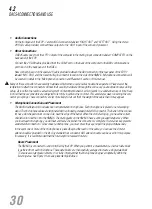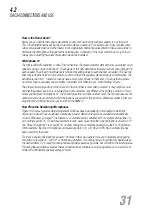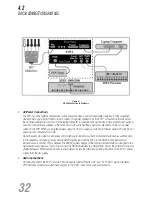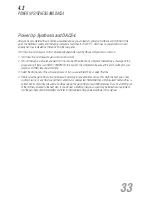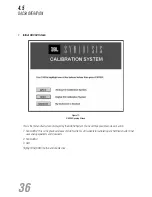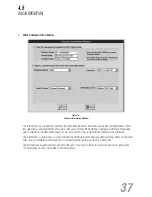
23
4.1
OPERATIONAL OVERVIEW
4.0
THE DIGITAL ACOUSTIC
CALIBRATION SYSTEM
When the physical installation of any Synthesis System is complete, the next step is to calibrate the system to meet factory
performance specifications. This is accomplished with the use of the proprietary JBL Synthesis Digital Acoustic Calibration
System (DACS4). DACS4 is a computer controlled acoustic measurement system that communicates directly with the
SDEC-1000/2500. After each channel is analyzed, corrective settings are transmitted to the SDEC. These settings are
stored in non-volatile memory, thus assuring that the settings are permanent. Normally, re-calibration of an SDEC is not
required. There are no controls on the SDEC that can disturb the memorized settings.
Operational Overview:
Proper calibration of an audio playback system is a very complex undertaking. The first requirement is to acquire test data
that accurately portrays what is actually happening in the room. Second, we must post-process this data to create a view
that is relevant to what we actually hear. Third, this data must be compared to some theoretical ideal. Last, corrective
action must be taken to make the actual listening environment more closely match the ideal. Properly administering this
process is usually a good day’s work even for an experienced acoustics engineer using sophisticated analysis devices.
Using DACS4, you will be able to perform this work in a few hours time.
Stimulus:
DACS4 uses pink weighted pseudo-random noise to stimulate the speakers for each test. This stimulus is used because it
contains equal energy per octave, and all frequencies from 16Hz to 20kHz are represented. The stimulus level is preset to
generate a sound level of 85dBC when the system is properly calibrated.
Data Acquisition:
Meaningful acoustic measurements cannot be accomplished by placing a microphone at a single position in the room
and running a test. The key premise of room equalization at low frequencies is that the equalization will be used only to
correct for excessive energy found in specific room resonances It must not be used to correct for narrow, deep, dips
caused by destructive acoustical interference. A measurement made at a single point cannot effectively identify reso-
nances and cannot discriminate against the relatively harmless acoustical interferences. The only effective method of
separating room resonances from acoustical interference is to sample the acoustic energy at several points in the room.
DACS4 employs five microphones distributed throughout the listening area. When the data acquired from these micro-
phones is spatially averaged, the resultant curve has effectively “averaged out” most of the destructive interference
components while still reporting on major room resonances. This is so because acoustical interferences occupy very






















